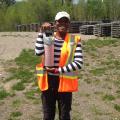Exploration Geophysics
Geophysics is the science of studying the Earth using the laws of physics. One branch of geophysics known as exploration geophysics is used on a regional scale for discovery of the Earth's economic resources, such as mineral deposits and hydrocarbon reservoirs. The geophysics research at the Harquail School of Earth Sciences (HES) at Laurentian University is mainly focused on exploration geophysics for mineral prospecting.
Geophysics is the science of studying the Earth using the laws of physics. On a global scale, geophysicists study the phenomena such as earthquakes, magnetosphere, earth magnetic and gravity fields, planets, and etc. However, another branch of geophysics commonly known as exploration geophysics is used in regional scales for discovery and exploitation of the earth economical resources such as mineral deposits and hydrocarbon reservoirs. The common geophysical prospecting methods include the potential field (gravity and magnetic), electromagnetic (EM), geo-electric, induced polarization (IP), and seismic methods.
The potential field surveys capture the variations in the earth’s magnetic and gravity fields in order to identify the magnetic susceptibility and density anomalies beneath the surface, respectively. The EM and geo-electric methods map the electrical resistivity of the subsurface. In an IP survey, besides the resistivity measurement, electrical chargeability of the subsurface materials are determined as well. The goal of the seismic method is to gather, process and invert seismic wave fields to obtain an interpretable image of the subsurface. In the seismic method, a controlled pulse of energy provokes a disturbance in the surface of the earth that propagates into the subsurface and reflections on geological boundaries propagate back to the surface of the earth. This information is recorded by an array of receivers, saved, processed for SNR enhancement, and finally, used to produce an image of the subsurface.
The geophysics research at the Harquail School of Earth Sciences (HES) at Laurentian University is mainly focused on exploration geophysics for mineral prospecting. It spans all aspects of the mentioned geophysical prospecting methods including data acquisition, processing, and interpretation. As part of Metal Earth project, a total of 1000 km long 2D seismic lines are gathered across the Canadian Shield in Quebec and Ontario Provinces in Fall 2017. The seismic data were collected with long offsets and various spatial sampling scenarios. This unique seismic dataset, combined with EM, potential field, and geoscience data collected along the same profiles, will be used to image shallow and deep structures of Canadian Shield for mineral exploration purposes.
Faculty & Research Scientists
-
Faculty
-
Post Doctoral Fellows
-
PhD Candidates
-
MSc Students
Additional Resources














